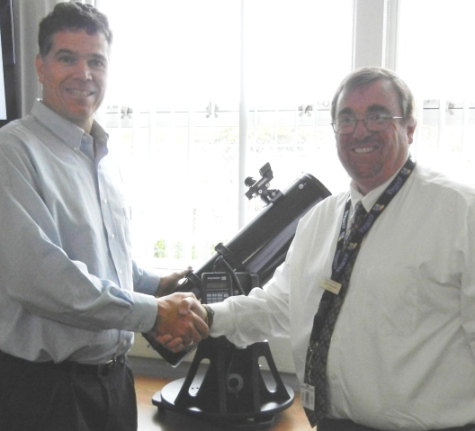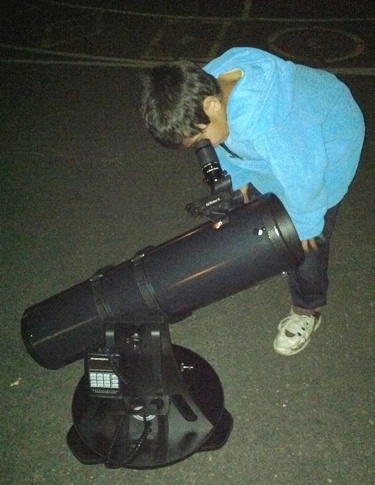|

| |
Sharing the Wow!
I've often said that Observing is half "Wow!", half 'sharing the "Wow!"'
(and half quoting bad math).
What keeps us hauling our scopes out to dark skies and to public gatherings,
like the 100+ Star Parties the San Diego Astronomy Association (SDAA) enables
every year, what sustains and inspires us, is seeing children and adults connect
to the universe: "It's real, it's right there! I had no idea!"
Sustaining the Wow!
When a thrilled family wanders away looking up, I am always plagued by the
worry "When is the next time they will look through a scope?" and "if they buy a
scope, will it be one that is good for them?"
In December 2010, I was notified by my employer,
Bentley Systems, Inc., of some available STEM grant
money. Shortly thereafter an article appeared in an astronomy magazine on
the New Hampshire Astronomical Society's Library Telescope program. As
they say: Eureka!
My goals included:
- implementing telescope sharing programs at a couple of local schools
- providing on-site telescope expertise and support to sustain the
programs
- providing a website to share observing and equipment skills (http://GoOutLookUp.net)
- providing enough appropriate on-line content to enable others to start
their own programs
| I picked my kindergartner's school, Curie Elementary
and Mission Bay High School as initial recipients of telescopes.
A shareable telescope for use in bright and dark skies has a unique
combination of requirements. The Orion Starblast 6i seemed to be
the best scope for our needs.
|

Mission Bay High Principal Hilgers (right) receiving
his Orion Starblast 6i |
Curie Elementary's Program
|
I was able to pick up Curie's Starblast in time to
bring it to their Annual Astronomy Night staffed by
SDAA.
In addition to my Orion XT12g and XT8i (shown to the right), the club
had seven other scopes, which were pointing to Jupiter, the Orion
Nebula, the Double Cluster and other bright sky objects.
I walked around the setups with the new Starblast over my head
shouting "You can check this scope out from the library!"
|
 |
| We now host in-person training after our monthly PTA
meetings; trainees can then reserve one of the scopes (we now have two).
The in-person training takes about 15 minutes (which isn't really
necessary, because everything we train is on the website, including
video. It does give families an opportunity to ask questions and to use
the scope outside afterwards).
Families are able to check out the scope for a week from the school
library during the school year.
The scopes are used for organized events such as the annual "Curie
Campout" which has 27 families this year looking forward to using both
scopes. |

Our first student looking through the scope during a
training session |
Extending the Wow!
The website has a lot of information gleaned from meeting the needs of the
Curie program. In addition to information on how to use the equipment and
learn the sky, there is information on how to start new telescope programs.
It will also be my starting point for soliciting grants for additional schools.
Wow!
|